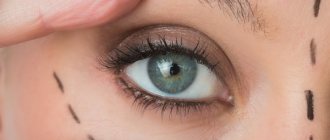Transconjunctival blepharoplasty is a type of surgical correction of the lower eyelid, in which surgical access is carried out from the conjunctiva. There are no incisions on the outside of the eyelid. Such an intervention avoids the appearance of a visible scar, but has moderate capabilities. It is used primarily to redistribute fatty tissue and eliminate bags under the eyes.
Transconjunctival blepharoplasty can reduce the recovery period to 10-15 days. For comparison, with the classical approach, complete healing takes about 1 month. The intervention is performed under local anesthesia, but if you want to sleep during the operation and have no contraindications to the administration of anesthesia, our anesthesiologist will administer general anesthesia.
What is transconjunctival blepharoplasty
Transconjunctival blepharoplasty is eyelid surgery without external incisions. It is considered the least traumatic and safest operation for correcting the shape of the eye, removing fatty hernias and restoring the youth of the “mirror of the soul”.
The difficult-to-pronounce term “transconjunctival” means that tissue is accessed through the conjunctiva of the eye. The conjunctiva is a thin transparent mucous membrane surrounding the eyeball, connecting with it in the area of the upper and lower eyelids.
Indications and contraindications
The following indications are required for blepharoplasty correction:
- Eversion of the lower eyelid. This leads to dry eyes because the eyelid does not fully adhere to the eyeball.
- Asymmetry. The pathology is caused by an incorrectly chosen surgical technique, non-compliance with the rehabilitation regime and the patient’s health condition.
- Scars of a rough nature. They appear due to the body’s predisposition to keloid and hypertrophic scars.
Plastic surgery should not be performed on patients with acute infectious or oncological diseases, diabetes mellitus, anemia, poor blood clotting, high blood pressure and myopathy. Contraindications also include menstruation in women, problems with the cornea, or recent eye surgery.
Difference from classical blepharoplasty
The main four differences between both techniques are access, indications, results and recovery period after surgery.
Access for classical blepharoplasty is made through incisions along the edge of the upper and/or lower eyelid. Despite the subtle seams, they are still present and remain forever in the form of a thin thread-like scar. Transconjunctival blepharoplasty of the lower and upper eyelids does not leave any incisions, since access occurs through the mucous membrane of the eyelid. The mucous membranes of the body heal quickly and without traces of intervention.
Indications for classical blepharoplasty are quite extensive. It is performed when the skin around the eyes is stretched, with a drooping eyelid, in the presence of wrinkles around the eyes, or if there is a desire to change the shape and shape of the eyes. The peculiarity of classical blepharoplasty is its radicality. Whereas transconjunctival blepharoplasty is indicated only for young skin that has not lost its ability to contract. Transconjunctival blepharoplasty is also performed in older patients, but provided that the skin remains capable of retraction (shortening). Some patients, even with stretched aging skin around the eyes, still insist on eyelid surgery with access through the mucous membrane. A plastic surgeon who yields to their persuasion risks getting a result that will disappoint the patient, and the patient will go to another doctor, convinced of the unprofessionalism of the one who performed plastic surgery of the upper and lower eyelids. Thus, the doctor’s choice between two blepharoplasty techniques should be made consciously and with all the responsibility.
The result of classical blepharoplasty is radical. The eyelids become tightened, the eyes look more youthful. For the next 10-15 years, you can forget about wrinkles under the eyes and age-related problems. Transconjunctival surgery gives a less noticeable, but more natural result. Its main purpose is to rid the lower eyelids of fatty hernias, which can occur both in young years due to genetics and due to age-related changes. After transconjunctival blepharoplasty, the look subtly “freshens”, the face as a whole looks healthier and more youthful. But with this access method, the doctor is unable to cope with sagging eyelid skin and an abundance of wrinkles.
The recovery period after transconjunctival blepharoplasty of the lower and upper eyelids is much shorter and easier to tolerate. Whereas classic blepharoplasty has all the consequences of a full-fledged surgical intervention, including swelling and bruising.
How to prepare for transconjunctival blepharoplasty
When preparing for surgery, it is important to stop drinking alcohol and smoking two weeks before surgery, this guarantees optimal recovery without oxygen starvation of the tissues.
It is necessary to collect a number of tests, including a general blood and urine test, a biochemical blood test, and an ophthalmologist’s report. Taking hormonal drugs and drugs that affect blood clotting should be stopped several days before surgery to avoid the risk of complications. It is important to avoid sunbathing and tanning beds a week before blepharoplasty, as surgery always carries the risk of subsequent hyperpigmentation.
You should not eat or drink on the day of surgery. You must come to the clinic without makeup or jewelry. All tasks should be distributed in such a way that nothing disturbs you during the week and no social activity is required. It’s good if there is the possibility of support from one of your relatives or friends.
Blepharoplasty under local anesthesia or general anesthesia
At the beginning, I would like to decide that it is more correct to call local anesthesia rather than “local anesthesia.” The word "anesthesia" refers to the name (definition) general anesthesia, although it is also correct to call it general anesthesia. Because anesthesia, as such, is only one of the methods (types) of anesthesia (pain relief) and it is associated with “turning off” the patient’s consciousness, with the use of narcotic analgesics (also inhaled gases) of central action, i.e. the effect is on the central nervous system, and not to the peripheral, as with the use of local anesthetics.
However, the patient’s consciousness can also be changed by other drugs: sedatives, hypnotics, and from the point of view of science, this is not anesthesia (since central analgesics are not used), but at the same time it seems to the patient that general anesthesia was performed, i.e. .To. he was asleep and “was not present” in the operating room (does not remember), because sleeping pills also have a general effect on the body, on the central nervous system (central nervous system), consciousness, but this can only be called anesthesia in one case, if analgesics (painkillers) were used ) central action, and that's it.
All this was invented by “bespectacled people” to communicate with each other at scientific conferences, the patient must understand:
- if he is awake and present in the operating room, then this is local anesthesia and its types (conduction, infiltration, etc.);
- if the patient was “absent” in the operating room (sleeping, dozing, etc.) - then for him this is general anesthesia (general anesthesia).
That’s it, no more digging and understanding of scientific terms. Patients absolutely do not need this. This leads to the obvious difference between local anesthesia and general anesthesia: local anesthesia is performed with drugs for local anesthesia (lidocaine, etc.), acting at the site of the incision and operation; general anesthesia is achieved through a general effect on the body and the central nervous system.
Local anesthesia is very effective: it does not hurt, only the first injection is sensitive, and if it is done correctly (thin needle, EMLA on the skin first), then you will not feel this either.
Patients are interested: “Is it possible to do blepharoplasty without general anesthesia under local anesthesia?” I answer. The blepharoplasty operation itself is minimal in terms of trauma to the body, so local anesthesia is quite sufficient for direct pain relief, but you need to understand that it is impossible to predict 100% that there will not be any allergic or toxic reactions, and also (if you are not “persistent tin "soldier) any systemic disorders: increased blood pressure (blood pressure), heart rate (tachycardia) to critical levels, which increases the load on the heart and blood vessels. Hence the risk of developing strokes and heart attacks. In addition, adrenaline is used in a solution for local anesthesia, which is also absorbed into the bloodstream and further constricts blood vessels and increases the heart rate. And they will “pick” your eye for 1-1.5 hours, which is not very comfortable or pleasant.
Well, and of course, blepharoplasty can be done under general anesthesia, for example, under ETN (endotracheal anesthesia) with the use of central analgesics and inhalational anesthetics, i.e. Under such anesthesia it is possible to perform any operation in principle. But in this case it will be “a cannon shot at sparrows,” which is not obviously necessary.
If you want to perform the operation in comfortable, safe and painless conditions, then the compromise for you will be combined anesthesia: local anesthesia + IV sedation (sedation, nap, sleep, etc.)
And yet, if you still decide to undergo purely local anesthesia, then I strongly recommend that you at least be under the supervision of an anesthesiologist-resuscitator. Let him not administer drugs for general anesthesia, but at the same time he will measure blood pressure, heart rate, etc., put an IV catheter in case something happens, he will always be able to come to the rescue.
I wish you a successful and safe local anesthesia, as well as good luck!
Author: Anesthesiologist-resuscitator M.V. Bakaushin
How is the operation performed?
Depending on the indications and complexity of the task, local or general anesthesia is required. In most cases, a combination of anesthesia using intravenous sedation and local anesthesia is used.
The operation rarely takes more than an hour. Depending on whether the operation is performed on the upper or lower eyelid, the doctor makes an incision on the conjunctiva of the upper or lower eyelid, respectively. Tissue dissection is carried out using a scalpel or laser. The second method is preferable because it causes minimal tissue trauma and the operation is almost bloodless. Laser exposure instantly coagulates blood vessels and avoids blood loss. Through transconjunctival access, internal tissues are exposed, through which fatty hernias are excised and the skin is tightened.
Rehabilitation: Micro-needle RF lifting.
Fractional thermolifting is used for a wide variety of areas of the face and body, including the most delicate ones, carefully adjusting the depth and intensity of the treatment.
- Microneedles are used to deliver RF energy to the desired tissue level, but the procedure is bloodless.
- Innovative technologies help launch regeneration processes, activate blood flow, and restore lymphatic drainage.
- RF needle lifting goes well with various procedures.
The skin tightening effect is observed immediately after the end of the session.
Subsequently, with the launch of the production of new collagen and elastin, the lifting effect increases and becomes more pronounced. More about the procedure
Rehabilitation period
Immediately after the operation, the patient remains in the clinic for several hours for medical supervision. If the operation was performed in the morning, then if it progresses well, the patient will be allowed to go home in the afternoon, 7-8 hours after the intervention. According to the schedule prescribed by the doctor, you must come to the clinic for a medical examination. Swelling and small bruises will disappear within a week.
Blepharoplasty is a minimally invasive intervention, which, however, requires strict adherence to all rehabilitation rules. The patient will have to get used to sleeping on his back on a high pillow to quickly get rid of swelling, protect his eyes with dark glasses, both from the sun and from bright light, not lift heavy objects and not engage in any physical labor that can increase intraocular pressure.
After surgery, it is important to be careful about the hygiene of the operated area, do not get it wet or expose it to sudden temperature changes. The use of cosmetics is possible only with the permission of a doctor. The doctor will prescribe a special ointment that must be used throughout the recovery period. In addition to the healing and restorative drug, the doctor may prescribe the use of special moisturizing drops after surgery. Careful adherence to all recommendations guarantees an impeccable result of the operation.
A slight inconvenience awaits patients who are accustomed to using eye lenses: for the first time after blepharoplasty, they will have to be abandoned so as not to cause irritation to the eye mucosa and to avoid the “dry eye” effect.
Both when preparing for surgery and after it, it is important to abstain for two weeks from factors that provoke oxygen starvation of tissues - tobacco and alcohol. These habits can become a catalyst for serious complications - tissue necrosis or prolonged healing. In addition, tobacco smoke irritates the mucous membrane of the eyes and provokes lacrimation, which does not at all speed up tissue healing.
Blepharoplasty of the lower eyelids has another limitation in the postoperative period - adherence to an anti-edematous diet. In order for the swelling to go away faster and the tissues to tighten, you need to exclude fried and salty foods, spicy and smoked foods from your diet. It is also important to avoid drinking coffee and carbonated drinks due to their dehydrating effects. Lack of sleep interferes with tissue repair, so it’s worth taking a short vacation and resting as much as possible. This will help the body quickly restore damaged tissue and all related functions.
Day 2-3
If the patient had stitches, they will be removed on these days.
If self-absorbable threads were used, there is no need to remove the sutures. The threads will dissolve on their own.
By the third day, bruises and swelling will begin to go away.
The main prohibitions on these and subsequent days:
- Refrain from physical activity.
- Do not use decorative cosmetics (preferably for about ten days).
With the doctor's permission, from 7-10 days you can use hypoallergenic decorative cosmetics for sensitive skin.
- Refrain from visiting solariums, baths, saunas.
- Do not go out into direct sunlight without protective glasses.
- Don't wear contact lenses.
- Don't strain your eyes. Limit yourself in using gadgets, watching TV, reading books.
- Follow your diet.
- Do not take medications without consulting your doctor.
Possible complications after surgery
Any surgical intervention is fraught with complications, both through the fault of the doctor and the fault of the patient or his individual reactions.
In the case of eyelid surgery, this may include headaches or double vision due to increased eye pressure. Often this phenomenon is associated with the very fact of the intervention and should go away on its own. However, if the patient is bothered by any deviations from the norm for a long time, he should immediately consult a doctor.
Various types of hematomas require immediate surgical intervention, as they can lead to irreversible consequences. Usually a puncture and forced removal of blood are prescribed. To avoid such consequences, you need to very carefully choose a clinic and a doctor for eyelid surgery.
If the surgeon removes too much tissue, the eyelid may turn out. In professional language this is called “ectropion of the eyelid” (inversion of the eyelid). To eliminate this complication, a repeat operation is required.
Tearfulness occurs when the tear ducts are displaced or pinched. Sometimes this effect goes away on its own, but you may need medical help after consulting an ophthalmologist.
Rare complications include harmless cysts that resolve on their own. A more complex complication is tissue scarring, which practically does not occur with transconjunctival blepharoplasty, except for the individual reaction of the patient.
Indications for surgery
First of all, surgical intervention is performed for patients who want to eliminate a cosmetic defect in the form of bags under the eyes, severe wrinkles, and sagging skin. The procedure is also indicated for the following conditions and diseases:
- damage to the protective septum of the eye, hernia formation;
- excessive drooping of the skin of the eyelids, which interferes with normal life activities;
- stretching of the skin above and below the eye, as well as in the corner above the eyebrow;
- excessive accumulation of subcutaneous fat, which forms large bags under the eyes.
If bags under the eyes are associated with severe sagging skin, the procedure will be ineffective and will only slightly improve the patient’s condition. With the transconjunctival method, it is possible to completely eliminate the bags only in the presence of excess adipose tissue.











